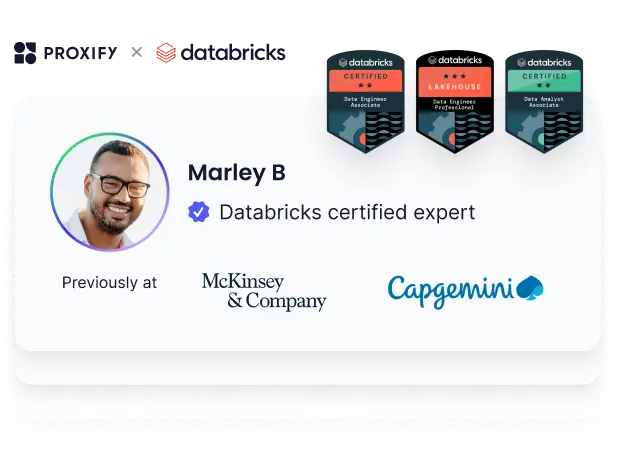NEW
Proxify is bringing transparency to tech team performance based on research conducted at Stanford. An industry first, built for engineering leaders.
Learn more
Databricks, bekend om zijn geavanceerde analytics en big data verwerkingskracht, is een dynamisch platform dat zowel ontwikkelaars als data scientists in staat stelt om te werken.
Laten we eens duiken in de essentie van het bouwen van een geweldig team dat kan navigeren en gedijen in de snelle wereld van Databricks.
Databricks begrijpen
Databricks biedt toegang tot vele gegevensbronnen en integratie met Apache Spark.
De flexibiliteit en aanpassingsmogelijkheden maken het mogelijk om een spectrum aan oplossingen te creëren, van gestroomlijnde hulpprogramma's tot innovaties op bedrijfsniveau. Met technologieën zoals Delta Lake en MLflow verfijnt Databricks de efficiëntie nog verder, waardoor naadloos gegevensbeheer en workflows voor machinaal leren mogelijk worden.
Databricks blinkt uit in high-performance dataverwerking en real-time analytics, gebruikmakend van Apache Spark's gedistribueerde rekencapaciteiten. Het uniforme platform vereenvoudigt de ontwikkeling in verschillende sectoren, waardoor het een ideale keuze is voor organisaties die op zoek zijn naar schaalbare oplossingen.
Terwijl trends zoals data lakes en AI convergentie het traject bepalen, blijft Databricks in de voorhoede van innovatie in data management en analytics.
Terwijl Databricks de wereldwijde big data en analytics markt blijft domineren, geven opkomende trends zoals de integratie van AI en machine learning, samen met een verhoogde focus op databeveiliging, vorm aan het toekomstige landschap. Met zijn toewijding aan innovatie en aanpassingsvermogen is Databricks klaar om de leiding te nemen in het revolutioneren van data-gedreven oplossingen voor de komende jaren.
Industrieën en toepassingen
Databricks vindt toepassingen in verschillende industrieën, waaronder financiën, gezondheidszorg, detailhandel en telecommunicatie. De veelzijdigheid ligt in de mogelijkheid om verschillende gegevensbronnen te verwerken, variërend van gestructureerde databases tot ongestructureerde gegevens zoals tekst en afbeeldingen.
Verschillende bedrijven gebruiken Databricks voor taken zoals voorspellende analyses, real-time gegevensverwerking en aanbevelingssystemen. De cloud-native architectuur maakt het een slimme keuze voor bedrijven die op zoek zijn naar schaalbare en kosteneffectieve oplossingen voor hun big data uitdagingen.
Technische vaardigheden die ontwikkelaars van Databricks moeten hebben
Bepaalde technische vaardigheden zijn niet-onderhandelbaar bij het inhuren van Databricks Developers. Deze basisvaardigheden stellen de ontwikkelaars in staat om het Databricks-platform effectief te gebruiken en zorgen ervoor dat ze uw dataprojecten naadloos kunnen uitvoeren van concept tot uitvoering.
- Bekwaamheid in Apache Spark: Een goede kennis van Apache Spark is cruciaal omdat Databricks sterk vertrouwt op Spark voor gegevensverwerking en -analyse.
- Spark SQL: Kennis van Spark SQL is essentieel voor het bevragen en manipuleren van data binnen Databricks omgevingen.
- Python of Scala programmeren: Competentie in ofwel Python, R, of Scala is noodzakelijk voor het ontwikkelen van aangepaste functies en het implementeren van datapijplijnen.
- Data engineering: Expertise in data-engineeringprincipes, waaronder datamodellering, ETL-processen en datawarehousingconcepten, is fundamenteel voor het ontwerpen van efficiënte datapijplijnen.
- Cloud-platform: Bekendheid met cloudplatformen zoals AWS, Azure, of Google Cloud is essentieel voor het implementeren en beheren van Databricks-clusters.
Leuke technische vaardigheden
Terwijl sommige vaardigheden essentieel zijn, kunnen andere vaardigheden het vermogen en aanpassingsvermogen van een Databricks ontwikkelaar vergroten en uw team in de voorhoede van innovatie en efficiëntie plaatsen. Enkele van deze vaardigheden zijn:
- Machine-leren en AI: Ervaring met machine learning algoritmen en AI technieken kan een ontwikkelaar beter in staat stellen om voorspellende modellen te bouwen en gebruik te maken van geavanceerde analysemogelijkheden binnen Databricks.
- Streamverwerkingstechnologieën: Kennis van stream processing frameworks zoals Apache Kafka of Apache Flink kan nuttig zijn voor het implementeren van real-time data processing oplossingen.
- Containerisatie en orkestratie: Inzicht in containerization tools zoals Docker en orkestratieplatformen zoals Kubernetes kan de inzet en het beheer van Databricks-omgevingen in containerized architecturen vergemakkelijken.
Interview vragen en antwoorden
1. Leg het concept van luie evaluatie in Apache Spark uit. Wat zijn de voordelen voor Databricks gebruikers?
Voorbeeld antwoord: Lazy evaluation in Apache Spark verwijst naar de optimalisatietechniek waarbij Spark de uitvoering van transformaties uitstelt tot het absoluut noodzakelijk is. Hierdoor kan Spark het uitvoeringsplan optimaliseren door meerdere transformaties te combineren en samen uit te voeren, waardoor de overhead van het schudden van gegevens tussen knooppunten wordt verminderd. In Databricks resulteert dit in een efficiënter gebruik van bronnen en snellere query uitvoeringstijden.
2. Wat zijn de voor- en nadelen van het gebruik van Delta Lake in Databricks in vergelijking met traditionele data lakes?
Voorbeeld antwoord: Delta Lake biedt verschillende voordelen ten opzichte van traditionele data lakes, zoals ACID-transacties, schema-handhaving en mogelijkheden voor tijdreizen. Het introduceert echter ook overhead bij opslag en verwerking.
3. Hoe gaat Databricks om met schema-evolutie in Delta Lake?
Voorbeeld antwoord: Databricks Delta Lake handelt schema evolutie af door middel van schema handhaving en schema evolutie mogelijkheden. Schemahandhaving zorgt ervoor dat alle gegevens die naar Delta Lake worden geschreven, voldoen aan het vooraf gedefinieerde schema, waardoor schemaconflicten worden voorkomen. Schema-evolutie maakt de automatische evolutie van het schema mogelijk om nieuwe kolommen of gegevenstypes te accommoderen zonder dat expliciete schema-updates nodig zijn.
4. Wat zijn de verschillende join strategieën die beschikbaar zijn in Spark SQL, en hoe optimaliseert Databricks join operaties?
Voorbeeld antwoord: Spark SQL ondersteunt verschillende join-strategieën, waaronder broadcast hash join, shuffle hash join en sort-merge join. Databricks optimaliseert join operaties door het analyseren van de grootte van datasets, de verdeling van data over partities en beschikbare geheugenbronnen om dynamisch de meest efficiënte join strategie te kiezen.
5. Beschrijf het proces van het optimaliseren van Apache Spark jobs voor performance in Databricks.
Voorbeeld antwoord: Het optimaliseren van Apache Spark-taken in Databricks omvat verschillende stappen, waaronder het effectief partitioneren van gegevens, het cachen van tussenresultaten, het minimaliseren van shuffling, het benutten van broadcastvariabelen en het afstemmen van configuraties zoals executorgeheugen, shuffle-partities en parallellisme.
6. Leg het concept van lineage in Databricks Delta Lake uit en het belang ervan voor data governance en lineage tracking.
Voorbeeld antwoord: Lineage in Databricks Delta Lake verwijst naar de historische registratie van datatransformaties en bewerkingen die zijn toegepast op een dataset. Het is essentieel voor data governance omdat het inzicht geeft in hoe gegevens worden getransformeerd en gebruikt, waardoor traceerbaarheid, auditing en naleving van wettelijke vereisten mogelijk worden.
7. Hoe gaat Databricks om met data skew in Apache Spark applicaties, en welke technieken kunnen gebruikt worden om dit te verminderen?
Voorbeeld antwoord: Databricks gebruikt verschillende technieken om met scheve gegevens om te gaan, zoals partitionering, dynamische partitionering en optimalisatie van scheve verbindingen. Daarnaast kunnen technieken als datareplicatie, salting en handmatige scheefheidsafhandeling door middel van aangepaste partitionering helpen om problemen met scheefheidsafwijkingen in Spark-toepassingen te beperken.
8. Leg het verschil uit tussen RDD's (Resilient Distributed Datasets) en DataFrames in Apache Spark. Wanneer zou u in Databricks het ene boven het andere verkiezen?
Voorbeeld antwoord: RDD's zijn de fundamentele gegevensabstractie in Spark en bieden transformaties en acties op laag niveau, terwijl DataFrames een API op hoger niveau bieden met mogelijkheden voor gestructureerde gegevensverwerking en optimalisaties. In Databricks hebben RDDs de voorkeur voor complexe, aangepaste transformaties of wanneer fijnkorrelige controle over gegevensverwerking vereist is, terwijl DataFrames geschikt zijn voor de meeste gestructureerde gegevensverwerkingstaken vanwege hun eenvoud en optimalisatiemogelijkheden.
9. Wat zijn de belangrijkste kenmerken van Delta Engine en hoe verbetert het de prestaties in Databricks?
Voorbeeld antwoord: Delta Engine in Databricks is een krachtige query-engine die is geoptimaliseerd voor Delta Lake. Het biedt functies zoals adaptieve query-uitvoering, gevectoriseerde queryverwerking en GPU-versnelling. Het verbetert de prestaties door query uitvoeringsplannen te optimaliseren op basis van datastatistieken, beschikbaarheid van geheugen en hardwaremogelijkheden, wat resulteert in snellere queryverwerking en beter gebruik van bronnen.
10. Hoe ondersteunt Databricks real-time stroomverwerking met Apache Spark Structured Streaming? Beschrijf de architectuur en de belangrijkste componenten.
Voorbeeld antwoord: Databricks ondersteunt real-time stroomverwerking met Apache Spark Structured Streaming, gebruikmakend van een micro-batch verwerkingsmodel met continue verwerkingsmogelijkheden. De architectuur omvat componenten zoals een streaming bron (bijv. Apache Kafka), de Spark Structured Streaming engine en sinks voor het opslaan van verwerkte gegevens (bijv. Delta Lake, externe databases).
11. Bespreek de uitdagingen van het omgaan met grootschalige gegevens in Databricks en hoe je ze zou aanpakken.
Voorbeeld antwoord: Het omgaan met grootschalige gegevens in Databricks brengt uitdagingen met zich mee die te maken hebben met de opname, opslag, verwerking en prestatieoptimalisatie van gegevens. Om deze uitdagingen aan te gaan, zou ik gebruik maken van datapartitionering, gedistribueerd computergebruik, caching, het optimaliseren van opslagformaten en geavanceerde functies zoals Delta Lake en Delta Engine voor efficiënt datamanagement en -verwerking.
12. Beschrijf het proces van het migreren van on-premises workloads naar Databricks. Welke overwegingen en best practices moeten worden gevolgd?
Voorbeeld antwoord: Het migreren van on-premises workloads naar Databricks omvat het beoordelen van bestaande workloads en afhankelijkheden, het ontwerpen van een architectuur die is geoptimaliseerd voor Databricks, het migreren van data en code, het testen en valideren van de migratie en het optimaliseren van de prestaties na de migratie. Best practices omvatten het gebruik van Databricks functies voor gegevensbeheer, het optimaliseren van het gebruik van bronnen en het bewaken van de prestaties.
13. Hoe ondersteunen Databricks machine learning en AI workflows? Bespreek de integratie met populaire ML frameworks en bibliotheken.
Voorbeeld antwoord: Databricks biedt een uniform platform voor machine learning en AI-workflows en biedt integratie met populaire ML-frameworks en -bibliotheken zoals TensorFlow, PyTorch, Scikit-learn en MLflow. Het maakt naadloze datavoorbereiding, modeltraining, hyperparameter tuning en implementatie mogelijk door middel van collaborative notebooks, geautomatiseerde pipelines en mogelijkheden voor modelregistratie, wat end-to-end ML lifecycle management mogelijk maakt.
Samenvatting
Het aannemen van het juiste talent voor Databricks rollen is cruciaal om de volledige mogelijkheden van dit dynamische platform te benutten. Door je te richten op de essentiële technische vaardigheden, zorg je ervoor dat je team de expertise heeft om dataworkflows effectief te beheren en te optimaliseren.
Door deze essentiële vaardigheden te bezitten en op de hoogte te blijven van de nieuwste ontwikkelingen in big data technologieën, kunnen Databricks ontwikkelaars effectief bijdragen aan hun teams en innovatie stimuleren in data-gedreven besluitvormingsprocessen.
Denk er bij het aanwervingsproces aan dat de kracht van uw organisatie in haar mensen ligt. Met het juiste team kunt u nieuwe mogelijkheden ontsluiten en uw organisatie naar nieuwe hoogten van succes stuwen in de wereld van big data en analytics.

















